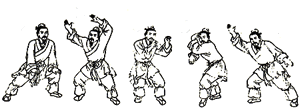
© Valley Spirit
Qigong, Green Way Research,
Valley Spirit Center, Red
Bluff, California, 2003-2017
Green Way Research, Cloud
Hands Home, City of Vancouver, State of Washington, Northwest USA, 2017-
五禽戲
Frolics of the Five Animals
Bear
Tiger
Monkey
Deer
Crane
Dragon
Animal Frolics
Bear
Introduction
Bear Frolic Qigong
There are many versions and variations of the Qigong Exercise set called The Frolics of the Bear. Over the centuries, many playful qigong practitioners have created versions of the Bear Qigong that suited their preferences and felt comfortable for their body. In addition, all psycho-somatic movement forms are naturally modified, in private practice, to suit the individual's body type, to accommodate injuries, to cope with aliments and illnesses, to adjust to levels of physical conditioning, to match different aims of practice (relaxation, fun, fitness, health, meditation, or martial arts), to provide variety, and to just "feel right." Consequently, if you are taught different versions of a movement called "The Bear" just enjoy yourself and play like a bear.
In the last thirty years, we have seen an increase in the number of English language books, magazine articles, and instructional videos and DVDs about the Five Animal Frolics. There have been increasing numbers of qigong and taijiquan masters that teach the Five Animal Frolics in the United States: Kenneth S. Cohen, John Du Cane, Franklin Fick, Paul Gallagher, Michael Gilman, Jiao Guorui, Jesse Tsao, Xue Zhi, Yang Jwing-Ming, etc.
Correspondences and Alchemical Associations of the Bear include strength, power, determination, stability, and a keen sense of smell.
Introduction and History of the Five Animal Frolics Qigong
Bibliography, Links and Resources
Bear Frolic Qigong
Alphabetical Index to the Cloud Hands and Valley Spirit Qigong Websites
Ancient
Way to Keep Fit. Compiled by Zong Wu and Li Mao.
Translated by Song Luzeng,
Liu Beijian, and Liu Zhenkai. Paintings by Zhang Ke Ren. Foreword by
Kumar
Frantzis. Bolinas, California, Shelter Publications, 1992. 211
pages, glossary. ISBN: 0679417893. Outstanding illustrations by Zhang Ke Ren. The
Five Animal Frolics are beautifully illustrated on pages 68-80.
Bear Frolic.
UTube Video, 2:08 Min. Performed by Anson Rathbone, 2007. As taught by
Deguang at NESA's Medical Qigong Class.
The Bear Frolic: Bibliography, Research,
Links, Notes, Lessons
Breathing Techniques
in Qigong and Taijiquan
Buddhist Qigong, Luohan Chi
Kung, Eighteen Buddha Hands Qigong
Chinese Healing Arts: Internal Kung Fu. Edited by William R. Berk.
Burbank, CA, Unique Publications. 209 pages. ISBN: 0865680833.
VSCL. Includes numerous translations of classic works. Five Animal
Frolics, pp. 57-70.
Cloud Hands Website:
Qigong and Taijiquan
The
Complete Book of Chinese Health and Healing. By Daniel Reid.
Random House,
1994. 484 pages. ISBN: 0877739293.
Correspondences and Alchemical Associations of the Bear
Correspondences and Alchemical Associations of the Animals of the Five Animal
Frolics Qigong
The Crane Frolic:
Bibliography, Resources, Links, Lessons, Notes
Daoist Philosophy, World View, Beliefs, Scriptures
The Deer Frolic:
Bibliography, Lessons, Links, Resources, Notes, Lore
The Dragon Frolic:
Bibliography, Links, Resources, Lessons, Notes, Lore
Drawing Silk: A Training Manual for T'ai Chi, 1988, p.9. Drawing Silk: Masters' Secrets for Successful Tai Chi Practice. By
Paul B. Gallagher. Third Edition. Fairview, North Carolina, Total Tai Chi, 2007,
1988.
245 pages. ISBN: 9781419663127. VSCL. The First Edition
was published as Drawing Silk: A Training Manual
for T'ai Chi. By Paul B. Gallagher. Guilford, VT, Deer
Mountain Taoist Academy, 1988. Reading lists, lists, 128 pages.
VSCL.
Eight Section Brocade
Qigong By Michael P. Garofalo, M.S. History and purpose of
this popular chi kung practice. Descriptions for each of the eight
movements, health benefits, comments, variations, extensive links and
bibliography, resources, quotations, animated .gif photographs of the movements,
and charts. This file is updated
on a regular basis as I add new material, links, notes, and resources. A.K.A: Baduanjin, Pa Tuan Jin, Eight Silken
Treasures, Ba Duan Jin, Pal Dan Gum, Ba Duan Gin, Pa Tin Kam, Otto Pezzi di Tesoro, Acht Delen
Brokaat,
Les Huit Exercices del la Soie, Eight Silken Treasures, Brocade Qigong, Wudang
Brocade Qigong, Silk Treasures Qigong, First Eight Buddha Lohan Hands.
Ecstatic Body Postures: An Alternate Reality Workbook.
By Belinda Gore. Foreword by Felicitas Goodman. Santa Fe, New Mexico, Bear
and Company, 1995. Endnotes, 284 pages. ISBN: 1879181223. VSCL.
Five Animal Frolics Qigong: Bibliography,
Resources, Lessons, Links, Quotations, History
Five Animal Frolics Qigong: Crane and Bear Exercises. By Franklin Fick.
Shen Long Publishing, 2005. 120 pages. Illustrated with b&w line
drawings. ISBN: 1411627768. VSCL.
The Bear Frolics Qigong is explained, with illustrations, on pp. 68-113.
Five Animal Frolics: A Form Workbook. A Complete Qigong Program for High Energy, Vitality and
Well Being. By John Du Cane. St. Paul, Minnesota, Dragon
Door Publications,
2002. Second Edition, 2002. 121 pages. Spiral bound
notebook. 100 photographs. No ISBN. John Du Cane
explains and provide photographs of demonstrations of 11 Bear movements and
postures, pp. 38-67. VSCL. "Daoism
celebrates and cultivates the art of living in accord with the cyclical play of
natural energies, maintaining an easy, humorous, yet commonsense approach to
everyday life. Daoism cultivates our capacity to spiral from the serene and
tranquil to the energetic and dynamic. In this spirit, the Daoists created
refined qigong systems of meditative movement to induce harmony with nature,
generate energy, and at the highest levels, to achieve spiritual illumination.
Qigong teaches us to harmonize body, mind and breath while using scientifically
choreographed movements to stimulate or relax our energy. Qigong bolsters the
primal, reproductive vitality, or "jing"; it potentiates the daily bioelectrical
energy, or "qi"; and it refines the light of our radiant spirit, or "shen".
Imagine yourself as a candle: the candle body is your jing, the flame is your
qi, and the candle light your shen. These three treasures are interdependent.
Cultivation of the one leads to cultivation of the others, just as neglect or
dissipation of the one will adversely affect the others. Qigong divides into two
main categories—the tranquil and the dynamic. But, typically of Daoist practice,
tranquil qigong will have a dynamic component—motionless on the surface, yet
moving the qi internally. Dynamic qigong will also cultivate tranquility,
learning to move vigorously from a still core. Skillful practitioners learn to
be aware of and incorporate the full spectrum of internal and external activity,
equally comfortable with the tranquil or the dynamic, always cultivating the
seed of one within the soil of the other. One of the most delightful and
accessible of the dynamic qigongs has to be the Five Animal Frolics. The
exercises combine the internal with the external, invigorating the organs and
soothing the nervous system, while strengthening and toning the external
musculature. They affirm a playful, uninhibited approach to meditative movement,
allowing for strong benefits without an overly serious slog for results.
The father of Chinese medicine, Hua To concluded that the single greatest secret
for a healthy life lay in the practice of correct movement. His analogy became
dear to the hearts of all tai ji enthusiasts: "A door’s hinge won’t get
worm-eaten, if you use it." Today we would say If you oil and use the hinge."
Qigong and tai ji movements, when properly performed, stimulate that internal
lubrication of free-flowing qi, blood, and lymph essential to our continued
health and sense of well being. Believing also that the highest healing skill is
to teach others to heal themselves, Hua To set out to create a complete
self-healing system that anyone could use to stay healthy or cure themselves of
most ailments. Synthesizing and refining a set of exercises based on a vast body
of ancient shamanic and folk healing knowledge, he created The Five Animal
Frolics. The Frolics incorporate many of the principles of tai ji but in a more
basic form. They are far easier to perform than tai ji, very pleasurable and
relatively simple to maintain as a daily practice. Individual sequences can be
used as quick, invigorating stress-buster; the full program is an exhilarating
therapeutic experience. The exercises model movement from the crane, the bear,
the monkey, the tiger, and the deer. These are animals with very distinctive
styles of movement. The idea is not merely to mimic the external motions of the
animal, but to internalize the nature of that animal as you practice. Each
Frolic also emphasizes different health benefits and you can choose a specific
animal for specific results. Their movements form arcs, spirals, waves and
spins, in accord with the Chinese belief that circular movement underlies all
mental and subtle energetic activity. To avoid imbalance, the movements are
sometimes slow, sometimes fast, and are deliberately designed to alternately
strengthen and soften the body."
Five Animal Sports Qigong Instructional DVD, 180 Minutes.
Instruction by Grandmaster Yang Jwing-Ming and Kathy Yang. ISBN:
978-1-59439-110-6. 2008.
Hatha
Yoga: The Hidden Language; Symbols, Secrets and Metaphor. By Swami
Sivananda
Radha. Foreward by B.K.S. Iyengar. Spokane, Washington, Timeless
Books, 1987,
1995. Index, 308 pages. ISBN: 0931454743. MGC. A
wonderful book filled with lore,
myths, symbols, stories, and metaphors about various yoga postures. Yoga
postures that embody
aspects of birds (pp. 180-225) include the Swan (Hamsasana),
Crane (Bakasana), Eagle
(Garudasana), Peacock (Mayurasana), and Cock (Kukkutasana).
The
Healing Promise of Qi: Creating Extraordinary Wellness Through Qigong and
Tai Chi.
By Roger Jahnke, O.M.D.. Chicago, Contemporary Books, 2002.
Index, notes, extensive
recommended reading list, 316 pages. ISBN: 0809295288.
VSCL.
Health Qigong Federation UK Five Animal Frolics
The
Jade Emperor's Mind Seal Classic. The Taoist Guide to Health,
Longevity, and Immortality.
Translated with commentary by Stuart Alve Olson. Rochester, Vermont,
2003. Index, bibliography,
216 pages. ISBN: 0892811358. Inculdes translations of
"The Immortals" by Ko Hung, and
"The Three Treasures of Immortality" by T'ien Hsin Chien. This
work was added to the Taoist Canon
between 912 and 1116 CE. VSCL.
Lifestyle Advice for Wise
Persons
Massage - Self-Massage,
Patting
The Monkey Frolic:
Bibliography, Links, Resources, Lessons, Notes, Lore
Nature Spirits: How to
Create Relationships the Nature Spirits of Animals
Power Qigong: The Bear and Tiger Frolics. Instructional DVD, 41
Minutes, by John Du Cane. St. Paul, Minnesota, Dragon Door Publications,
1999. Anti-Aging Series. ISBN: 0938045210. VSCL. "The
Bear is a great winter exercise. Slow, ponderous, but very strong, it warms the
body, strengthens the spleen, and builds vitality. The Bear's twisting waist
movements massage and invigorate the kidneys. The Bear is an excellent
preventive against osteoporosis, as it is known to fortify the bones. The
dynamic Tiger builds great power, strengthening your waist, sinews, and kidneys
and developing you internally. John DuCane presents proven qigong
techniques in a slow, follow-along format designed to optimize learning, without
having to constantly rewind and review. Improve your metabolism, digestion, and
elimination - for weight control, more youthful appearance, and higher,
longer-lasting energy. Stimulate the lymph sytem - for a stronger
immune system. Be less susceptible to the flu or colds and recover faster if you
do get sick. Improve your circulation - alleviating conditions such as arthritis
and chronic fatigue. Build stronger, more durable bones. Give your internal
organs an inner massage - retarding the aging process by restoring your organs
to peak efficiency. Increase oxygen in the tissues - reducing tensions, blocks
and stagnant energy. Lubricate the joints - for pain free movement and greater
flexibility. Soothe the nervous system - for feelings of contentment and
serenity."
Protect Your Knees in Bear
Movements Instruction by
Al Simon, 2009. UTube Video, 3:54
pm.
Qigong Essentials for Health Promotion. By Jiao Guorui.
Translated by Jiao Tielan. Beijing,
China Reconstructs Press, 1988. ISBN: 750720100. ASIN: B000B6TA54. The Animal
Frolics are discussed and explained on 190-236. The text includes
illustrations (line drawings). VSCL.
Relaxation (Sung, Song, Shoong),
Effortless Action, and
Qigong Links,
bibliography, quotes, and notes.
By Mike Garofalo.
Ripening Peaches:
Daoist Studies and Practices. Taoist scriptures, bibliography,
Quanzhen Daoism, Neidan, gardening, tea, history, qigong/daoyin, readings, etc.
Six Taoist
Healing Sounds Research by Mike Garofalo.
Standing Bear: Valley Spirit T'ai Chi Ch'uan Level 1 Ranking
Requirements
Standing Meditation
(Zhan Zhuang)
Subject Index to the
Cloud Hands Website
Taijiquan (Tai Chi
Chuan) and Qigong
The Taoist Body. By Kristofer Schipper. Translated by Karen C.
Duval. Foreword by Norman Girardot. Berkeley, California, University of California
Press, 1993. Originally published in French in 1982 as Le Corps Taoiste.
Notes, bibliography, index, xx, 273 pages. ISBN: 0520082249. VSCL.
Taoist
Classics. The Collected Translations of Thomas Cleary. Boston,
Shambhala Press. Four Volumes:
Volume
One, 296 pages, 2003.
Volume
Two, 640 pages, 1999. Volume Three, 304 pages, 2001.
Volume
Four, 464 pages, 2003.
The Tiger Frolic:
Bibliography, Links, Resources, Lessons, Notes
Valley Spirit Qigong Website
Red Bluff, California. Instructor: Michael Garofalo.
VSCL = Valley Spirit Center Library, Red Bluff, California.
The Way
of Qigong: The Art and Science of Chinese Energy Healing, 1997, pp. 206-209.
The Way
of Qigong: The Art and Science of Chinese Energy Healing. By Kenneth
S. Cohen.
Foreword by Larry Dossey. New York Ballantine Books, 1997. Index,
notes, appendices, 427 pages. ISBN: 0345421094. One of my favorite books:
comprehensive,
informative, practical, and scientific. VSCL.
Ways of Walking: Poems,
Quotes, Sayings, Bibliography, Links, Lessons, Resources
The Web
That Has No Weaver: Understanding Chinese Medicine. By Ted J.
Kaptchuk,
O.M.D.. Chicago, McGraw Hill Contemporary Books, 2nd Edition, 2000.
Index, bibliography,
appendices, notes, 500 pages. Foreword by Margaret Caudill, M.D., and by
Andrew
Weil, M.D. ISBN:
0809228408. An excellent introduction to traditional
Chinese medicine and modern research on the topic. VSCL.
Wild Goose Qigong: Links, Bibliography, Quotes, Notes
Winter Months: Quotes,
Poems, Sayings
Wu Qin Xi (Five Animal Frolics): Chinese Health Qigong. Compiled
by the Chinese Health Qigong Association. Beijing, Chine, Foreign
Languages Press, 2007. 102 pages, includes an instructional DVD.
ISBN: 9787119047799. VSCL.
Yi Jin Jing Qigong
(Muscle/Tendon Changing Qigong): Bibliography, Links, Resources, Lessons.
By Mike Garofalo.
Postures,
Routines, Names of Movements
Bear Frolic Qigong
Jiao Guorui, "Qigong Essentials for Health Promotion," Bear Frolic, 1988
Beginning Movement
1. Bear Footwork
2. Rocking Movement
3. Downward Pressing Movement
4. Leaning Movement
5. Forward Pressing Movement
Ending Movement
Qigong Essentials for Health Promotion. By Jiao Guorui. Beijing, China Reconstructs Press, 1988. The Bear Folic is described and illustrated on pp. 195-202.
Paul Gallagher, "Drawing Silk," Bear Frolic, 1988
Bear Turns (Twists)
Bear Pushes Behind
Bear Pushes Down
Bear Puts Out Claws
Bear Double Push with Palms
Bear Double Push to Ground (Bending Forward Side to Side)
Bear Double Push to Ground (Sit Back as You Push Out)
Bear Walk: Bear Ambles Through the Woods
Bear Walk with Fists
Bear Walk: Pointing at the Sun, Holding Up the Moon
Bear Walk: Plucking Berries
"Drawing Silk: Masters' Secrets for Successful Tai Chi Practice." By Paul B. Gallagher. Third Edition. Fairview, North Carolina, Total Tai Chi, 2007, 1988. pp. 1-9, 214-215.
John Du Cane. "The Five Animal Frolics Workbook," 2002.
1. Bear Turns
2. Bear Pushes Behind
3. Bear Pushes Down
4. Bear Puts Out Claws
5. Bear Double Push
6. Bear Push to Ground
7. Bear Pushes Back
8. Bear Ambles Though the Woods
9. Bear Walk with Fists
10. Pointing at the Moon, Holding Up the Sun
11. Bear Plucking Berries
Five Animal Frolics: A Form Workbook. A Complete Qigong Program for High Energy, Vitality and Well Being. By John Du Cane. St. Paul, Minnesota, Dragon Door Publications, 2002. Second Edition, 2002. 121 pages. John Du Cane explains and provide photographs of demonstrations of 11 Bear movements and postures, pp. 38-67.
Franklin Fick. "Five Animal Frolics Qigong: Crane and Bear Exercises," 2005.
1. Flopping Bear [Ringing the Temple
Gong]
2. Fishing Bear I & II [Cloud Hands]
3. Turning and Tipping Bear
4. Squatting Bear
5. Rolling Bear
6. Hibernating Bear
7. Bear Crosses the Ice I & II
8. Pushing Bear: A. Bear Pushes to the Side. B.
Bear Pushes Up. C. Bear Pushes Down.
9. Marauding Bear: A. Bear Rolls Back. B. Mauling
Bear. C. Bear Take Down
10. Looking Bear
Five Animal Frolics Qigong: Crane and Bear Exercises. By Franklin Fick. Shen Long Publishing, 2005. 120 pages. ISBN: 1411627768. The Bear Frolics Qigong is explained, with illustrations, on pp. 68-113.
Anson Rathbone. "Five Animal Frolics: Bear," 2007
1. Bear Walk
2. Bear Climbs
3. Push
4. Toss the Picnic Table
Bear Frolic. UTube Video, 2:08 Min. Performed by Anson Rathbone, 2007. As taught by Deguang at NESA's Medical Qigong Class.
Chinese Health Qigong Association. "Wu Qin Xi," 2007
1. Rotating the Waist Like a Bear
2. Swaying Like a Bear
"Wu Qin Xi." By the Chinese Health Qigong Association, 2007. The two Bear Frolics exercises are described on pp. 54-65.
Michael Garofalo. "Bear Frolic of the Five Animal Frolics," 2009
Bear Postures and Stances
1. The Big Bear Turns from Side to Side
2. The Grizzly Bear Attacks with Its Claws
3. The Little Bear Swings from Side to Side
Bear Frolic Qigong version by Michael P. Garofalo, 2009.
Lessons, Instructions, Suggestions,
Comments
Bear Frolic Qigong
There are many versions and variations of the Qigong Exercise set called The Frolics of the Bear. Over
the centuries, many
playful qigong practitioners have created versions of the Bear that suited their
preferences and
felt comfortable for their body. In addition, all psycho-somatic movement forms are naturally modified, in private practice,
to suit the individual's body type, to accommodate injuries, to cope with
aliments and illnesses,
to adjust to levels of physical conditioning, to match different aims of practice (relaxation, fun, fitness, health, meditation, or martial
arts), to provide
variety, and to just "feel right." Qigong is well known for its
variety and creativity. Consequently, if you are
taught different versions of a set of movements
called "The Bear Frolic Qigong," just enjoy yourself and play like a
bear.
In the last thirty years, we have seen an increase in the number of English language books, magazine articles, and instructional videos and DVDs about the Five Animal Frolics. There have been increasing numbers of qigong and taijiquan masters that teach the Five Animal Frolics in the United States: Kenneth S. Cohen, John Du Cane, Franklin Fick, Paul Gallagher, Michael Gilman, Jiao Guorui, Jesse Tsao, Xue Zhi, Yang Jwing-Ming, etc.
I have selected eight postures and movement forms for the Bear Frolics exercises. I have draw these exercises from the lessons of many master qigong teachers. I chose what Bear Frolic exercises appealed to me from the scores of different Bear Frolics exercises that I studied.
In general, bear forms emphasize turning, twisting, and bending at the waist; and a focus on the power of the shoulders and upper back when reaching, grabbing, and "clawing." Bear forms usually have the feet separated in a horse stance or lower lunges, which helps exercise (stretch and strengthen) the lower body.
Bear Frolic Qigong
Version by Michael P. Garofalo
Many versions since 2003. Latest Version: April 5, 2017.
When I first learned Chi Kung mind-body practices in 1985, we rested between
each exercise posture/form/asana. We would stand still, be quiet, breathe
softly, soften the soul, look forward with a soft focus or nearly close the eyes
(don't let your visual dominate), let the mind calm, be centered, be stable, be
rooted. We stood with arms gently at the side of the hips, fingers
relaxed, the crown of the head lifted, shoulders down, sung, detached
from the locomotive of the mundane mind, energy coursing though body, powerful
dantien, energized. The feet were close together. Just stand
still!
Have an attitude that might best be described as positive, exploratory, experimental, mindful, pride in your ability to exercise self-control and self-discipline, dignified, a can-do kind of person. "Transforming" yourself into a Bear requires imagination, pretending, playing, mimicking, observing, and some ideas about the lore of bears. There are few limits to the range of our imagination and fancies. You must have realistic attitudes about exercising, fitness, and the somatic arts. You must have the willingness to work, exert yourself, make some physical efforts.
So, Qigong (Chi Kung) includes resting postures between each exercise sequence. When doing the Bear Frolic exercises the resting positions you might use include:
Standing and Resting
Stances or Postures or Asanas for Standing and Resting
1. Just Stand Still! (As outlined above.) Yoga practitioners use two yoga poses/asana for standing and Resting: Tadasana (Mountain Pose) and Samasthiti (Standing Unmoved). Yoga and Chi practitioners/players/doers both practice and study this dignified, calm, poised, attentive, polite, determined, respectful, and needed standing resting posture.
2.
The Wu Ji Stance.
I have described this standing position in my webpage on
Standing Meditation
(Zhang Zhuang).
3. The Bear Spirit Posture: "The name of this
posture is derived from a wonderful carving of the Northwest Pacific Coast
Indians in which the Grandfather Bear Spirit, the Great Healer, stands behind a
shaman who holds the pose. It is very old and, of all the postures, is the most
widely known. Evidence of it has been found in countries throughout the world,
and historically it has existed from 6,000 BCE to the present."
- Belinda Gore,
Ecstatic Body Postures, p. 49.
4.
The Standing Bear Stance, Variation I:
Take a wide horse stance.
Feet can be pointing straight ahead or pointing out from your body
at a 45° angle. The knees should be
bent as you squat down. The knees should be in line with the feet. The depth of the squat will depend upon your level of conditioning and
any body mechanics or injury issues you may have. Try to squat down a
little
more with every
second repetition of this exercise. Back should be straight. Torso
should be centered and upright.
Rest your hands on the sides of your thighs, just above your hip bones. Your elbows should be
pointing out to the sides at a 90°
angle from the direction you are facing: if you are facing north (N12), your right
elbow would point to the east
(E3) and the left elbow to the west (W9). With your eyes, take a wide
angle and soft focus. Breath naturally,
deeply, and comfortably - as you bend down, breathe out; inhale as you rise up.
[Posture 2 below.]
Rest when you need to rest. Chi Kung aims to be gentle and healing. Stop when you need to stop. But, don't dally, chit-chat, or waste your exercise time; be determined to accomplish your exercise objectives. Rest and then get back to work. The bottom line is "Kung" or "Gong" (Chi Kung or Qi Gong): Doing the Exercise, Working at the Exercise, Leaning the Exercise, Becoming Skilled and Accomplished in the Exercise. Mastery comes through long hours of varied somatic efforts (read the Aikido Master, George Leonard).
If you practice with a group, then follow and show respect to the reasonable etiquette, rules, protocols, and rituals of the group. Rest when they permit or encourage rest.
You can practice the Bear Frolics alone. Rest appropriately during solo practice.
Honor the Standing Resting Posture. So, stop reading now, and stand up.
.
1. The Big Bear Turns from Side to Side
Movement Description of Big Bear Turns from Side to Side
Begin in your favorite simple
standing
posture. [Posture 1 below]
Step out to the left into a Horse Stance. Face
towards N12. The Horse Stance should feel be
rooted, centered,
balanced, and stable.
Place your hands on your hips. [Posture 2] Knees will be
bending throughout this exercise.
Bend the upper torso down, flexing forward, keep the back straight and head in
line with shoulders. [Posture 3]
Move the upper torso slowly towards the right side to E3. Try to remain
bent forward until you reach E3. Inhale. [Posture 4]
Keep your
hands on your hips throughout this exercise. Try to stay
relaxed and avoid
unnecessary tension.
Gradually lift the head and torso until you are upright and the face and chest
are facing towards E3. [Posture 5]
Your right elbow
should be pointing towards S6 and your left elbow pointing towards N12.
[Posture 6]
Gently turn the head only to the left and look towards N12. Intently gaze
towards N12. Enjoy the stretch. Exhale. [Posture 6]
Gently bring the head back to face towards E3, the whole body is in an extended
and fairly upright
posture. [Posture 7]
Bend forward at the waist and draw the head and torso downward towards E3.
[Posture 8]
Continue turning to the left, drawing the chest downward, hands on hips, head in
line with shoulders, and move back to a centered position. [Posture 9]
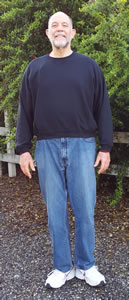 |
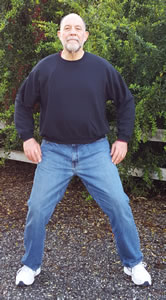 |
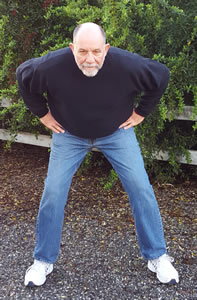 |
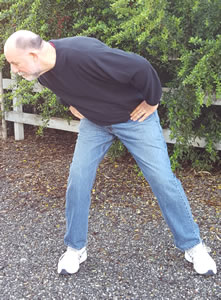 |
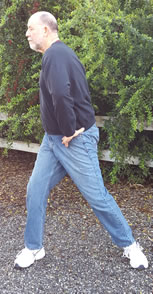 |
|
| Posture 1 | Posture 2 | Posture 3 | Posture 4 | Posture 5 | |
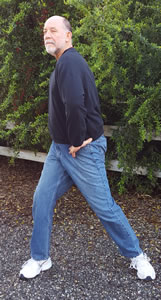 |
 |
 |
 |
||
| Posture 6 | Posture 7 | Posture 8 | Posture 9 |
Move the upper body, flexed
forward, from right side to the left side for 90 degrees, moving from N12 to W9.
Inhale.
Repeat a mirror image of the above description of postures and movement, but to
the left side.
Gradually lift the head and torso until you are upright, and the face and chest
are facing towards W9.
Your right elbow
should be pointing towards N12 and your left elbow pointing towards S6.
Gently turn the head only to the right and look towards N12. Intently gaze
towards N12. Enjoy the stretch. Exhale.
Gently turn the head only back to the left, and face W9.
Bend forward at the waist and draw the head and torso downward towards W9.
Move the upper body, flexed forward, from the left side to the right side for
180 degrees, moving from W9 to E3. Inhale.
Repeat the movement sequence from right side to left side, 3 to 8 eight repetitions.
Return to a centered position. [Posture 9]
Return to a comfortable standing meditation posture like the
Bear Spirit Posture or
Wu Ji Stance. [Posture 1]
Breathe freely, comfortably, and
deeply during this exercise. The inhaling and exhaling cues are how I
breathe, but these are just suggestions.
Try to avoid too much muscular tension as you move from side to side and up and
down. Extend rather than tense muscles.
Move slowly and comfortably.
Try to stay relaxed (Sung),
alert, calm, and peaceful.
Visualize, if you like, a mother bear coming out of a cave and powerfully
turning from side to side to survey the outside world.
This version of the "Big Bear Turns from Side to Side" is the same as the version in the Eight Section Brocade Qigong, and with the moving demonstration.
I sometimes use this flowing, gentle, vinyassa exercise movement in my hatha yoga classes.
2. The Grizzly Bear Attacks with Its Claws
From the Bear Meditation Stance step out to the left into the Standing Bear Stance, Variation II.
The Standing Bear Stance, Variation II:
Take a wide horse stance.
Feet can be pointing straight ahead or pointing out from your body
at a 45° angle. The knees should be
bent as you squat down. The knees should be in line with the feet. The depth of the squat will depend upon your level of conditioning and
any body mechanics or injury issues you may have. Try to squat down a
little
more with every
second repetition of this exercise. Back should be straight. Torso
should be centered and upright.
Lift both hands up with the palms facing to the front, fingers open like the
claws of a bear. The elbows are bent with the upper arms parallel with the
floor. Look forward. Face towards N12.
Movement Description of The Grizzly Bear Attacks with Its Claws
Slowly turn at the waist towards the right side, by 90 degrees until you are
facing E3.
Keep the hands up with the elbows bent.
Look towards E3, bring the hands forwards about 12 inches as if you are
attacking with the hands. Exhale as hands move forward slowly.
Draw the hands back into a centered stance.
Slowly turn at the waist towards the left side, by 180 degrees until you are
facing W9.
Look towards W9, bring the hands forwards about 12 inches as if you are
attacking with the hands towards W9. Exhale as hands move forward slowly.
Draw the hands back into a centered stance.
Slowly turn at the waist towards the right side, by 90 degrees until you are
facing N12.
Slowly bend at the waist, flexing forward and down. Draw both elbows
inward and claw downward until the hands are behind the heels. Exhale as
you bend down.
Slowly rise upward until you are back into a centered position, Standing Bear
Stance, Variation II. Look towards N12.
Arms are raised and to the sides.
Repeat the movement sequence 3 to 8 times.
Return to Bear Spirit Posture or Wu Ji Stance.
Franklin Fick calls this exercise the "Turning and
Tipping Bear." John Du Cane calls part of this exercise the "Turning Bear."
The Bear has a gentle, peaceful, and nurturing side, a Yin side, as well as, as circumstances dictate, a fierce, powerful and destructive side, a Yang side. Both aspects must be acknowledged and integrated into the practice of the Bear - as we try to become One with the Great Bear. Most bears are omnivorous or carnivorous - hunters, stalkers, attackers.
3. The Little Bear Swings from Side to Side
Movement Description of The Little Bear Swings from Side to Side
Stand with your feet a comfortable distant apart,
less than shoulder width. Toes should point forward. Face N12.
Keep your knees over your feet in this exercise.
Turn the upper body to the right side.
Draw the left hand up and tap the upper right chest (pectorals) with the left
hand or lightly clenched left fist.
Draw the right hand to the lower back and tap the left kidney area with the back
of the right hand or lightly clenched right fist.
End by facing somewhere from NE2 to E3. Upper torso remains upright.
Swing the upper torso from the right side E3, 180 degrees to the left side, to
face somewhere from NW10 to W9.
As the upper body moves from right to left, swing the arms to the other side.
Draw the right hand up and tap the upper left chest (pectorals) with the right
hand or lightly clenched right fist.
Draw the left hand down hand to the lower back and tap the right kidney area
with the back of the left hand or lightly clenched left fist.
Slowly move from side to side as you become comfortable with the movement flow.
You can speed the movement flow up as you become more skilled.
Repeat for as many repetitions as you would enjoy doing.
Breathe freely, comfortably, and deeply during this exercise.
Return to Bear Spirit Posture or Wu Ji Stance.
Alternate Names: Ring the Temple Bell, Swaying from Side to Side, Reverse Bear, Swinging Arms, Turning Waist, Constant Bear, Knocking at the Gate of Life, Big Bear, Washing Machine. Roger Jahnke calls this exercise "Ringing the Temple Gong" in his excellent book The Healing Promise of Qi, 2002, p. 70-71.
Some Qigong players slap, tap, or hit the body quite vigorously, with a kind of intention to "toughen" the body, supposedly helping them to create an "iron shirt" to enable them to withstand blows without being injured.
Cheng Man-ch'ing: Master of Five Excellences. Translation and commentary by Mark Hennessy. Berkeley, California, Frog, Ltd., 1995. On pages 113-117, there is "An Explanation of the "Constant Bear." Cheng Man-ch'ing (1901-1975) was a famous Taijiquan master and Doctor of Traditional Chinese Medicine. "It means "ch'ang" or constant, and refers to the constant, daily swinging to and fro of the bear's waist. So, this move should be called The Constant Bear. The Constant Bear combines the Five Animal Frolics and t'aichi into a single move." p. 114 "I bequeath the Constant Bear movement to the elderly, the sick, and the frail. It is a wonderful, traditional exercise which is both simple and easy. You can also use it for self-defense until you are years old. All this is easily obtained. Although my explanation is short and simple, if you understand its principles and practice with perseverance, after as few as one hundred days of moving your ch'i, you will notice a marked improvement in health and strength and no longer need to worry about illness. It is truly a "sacred raft" to strengthen our bodies and bears no semblance to other well know yet inferior exercises." p. 115
In 1983, while living in Hacienda Heights, California (home of the famous Hsi Lai Buddhist Temple), I walked most mornings at Burton Park. It was a lovely park in a suburban neighborhood with a large circular concrete walking pathway. As I walked and exchanged good mornings ("Zao An" = good morning," "Ni Hao Ma" = how are you") with many Chinese people, I observed many older women gathered in small groups and chatting as they swung their arms from side to side. I have watched thousands of Taijiquan and Qigong players do The Little Bear Swings from Side to Side.
Protect Your Knees in Bear Movements Instruction by Al Simon, 2009. UTube Video, 3:54 pm.
4. The Brown Bear Digs for Food
Movement Description of The Brown Bear Digs for Food
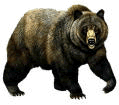
Bear Frolics Qigong
Bear Lore, Information, Facts,
Quotes, Links
"The Bear appears clumsy on the outside, but is alert and spirited within.
Ponderous and solid, sunken and stable, but with lightness concealed internally.
Its powerful flanks shake while moving and can be used to strike.
Ch'i sinks to the Dan T'ien and remains in the Middle Court."
- The Five Animal Classic, Translated by Paul B. Gallagher
Drawing Silk: A Training Manual for T'ai Chi, 1988,
p.9.
"Awkward looking but clear in mind,
It walks with lightness inside heavy steps,
Gathering Qi at Middle Dantian,
It shakes and rampages with force in the shoulders."
The bear looks awkward and clumsy, soft as if without bones, its temperament is
stable, simple and honest, and it walks with heavy steps. However,
flexibility and steadiness are hidden within the heavy steps. Do not mimic
the heavy, simple and hones bearing of the bear only, but also try to show the
flexibility and steadiness during the exercise. Shaking and rocking are
features of the bears movements, so exert forces with the upper arms (including
the shoulders, elbows, hands, hips, knees and feet). Conduct Qi to the
Middle Dantian, so as to accelerate deep abdominal respiration and form Dantian
Qi.
Persistent practice will help strengthen the constitution as well as functions
of the spleen and stomach."
- Jiao Guorui, Qigong Essentials for Health Promotion, 1988,
pp. 193-195
The practice of the Bear will warm up and stimulate the body. In qigong healing arts the practice of the Bear is recommended for stimulating and improving the functioning of kidneys and spleen, and for strengthening the bones.
"Taiji Quan movements evolved from this ancient
lumbering gait of a bear, unfortunately due to the linguistic drift and
misinterpretation, the Great Bear Polar Circle remains hidden for most
practitioners.
If one retraced to an older practice of the Five Animal frolics,
one can still see the original lumbering Gait of a black bear frolic swaying
side to side. If Taiji Quan did evolve from the Five animal frolics then the
Taiji form must contain within its structure a Bear movement. Such discovery re-connects me to the ancient Complete
Reality Sect of Taoist Ritual and opens my eyes to the depth of Taiji practice.
That the very functioning of the Taiji form is a Shamanistic journey of
recreating the Heavenly drama of the Ursula Major constellation which contained
the Big Dipper. With the Great Bear Rite as part of my practice of
Taiji movements, this transported my consciousness to a level that is universal. My body became part of the Cosmos. The movements took on a numinous quality.
- The Great Bear
Star Steps, Sat Chuen Hon
To fully experience the Five Animal Frolics we need to keep in mind the "Frolics" aspect of this movement art: being playful and exuberant, freeing up our time for fun, delighting in bodily movements, enjoying games of imitation, taking pleasure in the moment, and delighting in the exercise of fantasy and imagination. We should be smiling as we enjoy our playful frolics. We should strive to return to our youth, and rekindle those memories of our joyful childhood games, innocence, freedom of fancies, and silliness. We are never too old to embrace that precious child within each of us.
"Christopher Robin and I walked along
Under branches lit up by the moon
Posing our questions to Owl and Eeyore
As our days disappeared all too soon
But I've wandered much further today than I should
And I can't seem to find my way back to the Wood
So help me if you can
I've got to get back
To the House at Pooh Corner by one
You'd be surprised
There's so much to be done
Count all the bees in the hive
Chase all the clouds from the sky
Back to the days of Christopher Robin and Pooh."
- Return to Pooh Corner, Words
and lyrics by Kenny Loggins, 1969, MCA Music
The Complete Tales of Winnie-the-Pooh. By A. A. Milne. With
decorations by Ernest H. Shepard. New York, Dutton's Children's Books,
1994. 344 pages. Color illustrations, hardbound. ISBN:
9780525457237. Originally published in 1926, 1954. Over 26 million
copies of Winnie-the-Pooh books by A. A. Milne have been sold since 1922.
This book includes: Winnie-the-Pooh, and The House at Pooh Corner,
VSCL.
The Te of Piglet. By Benjamin Hoff. New York, Penguin Books, 1992. 257 pages. ISBN: 0140230165. VSCL.
The Tao of Pooh. By Benjamin Hoff.
New York, Penguin Books. VSCL
The most famous literary Bear is Winnie the Pooh. Over 26 million English language books by A. A. Milne about the Pooh Bear and his friends have been sold since 1926, the books have been translated into scores of languages, and Disney Films has made him even more famous and a lucrative commodity line. Benjamin Hoff has explored how Pooh Bear is a quintessential "Taoist Bear."
So ... it is just fine for you to Dance like a Bear.
Become a Silly Bear for
a awhile.
Enjoy the real honey of just being right were you are,
here and now, content,
Pooh, it is quite easy.
"For the Northern Utes, only the wisest, most experienced holy men and
women dare to declare that:
I am like a bear.
I hold up my hands
Waiting for the sun to rise."
- Annis Pratt, Dancing
With Goddesses, p. 341
"The Bear is the symbol of strength, power, and healing wisdom. In
ancient China, the shaman
healers wore bear masks and may have imitated the stepping of the bear in ritual
dance."
-
The Way
of Qigong: The Art and Science of Chinese Energy Healing, 1997, p.
200.
"The Bear is a great winter exercise. Slow, ponderous, but very strong,
it warms the body, strengthens the spleen, and builds vitality. The Bear's twisting waist
movements massage and invigorate the kidneys. The Bear is an excellent preventive against
osteoporosis, as it is known to fortify the bones."
- John Du Cane, Power
Qigong
"Bears are large heavy mammals belonging to the family Ursidae. They are
found largely in northern temperate regions and are widely distributed in North America, Europe,
and Asia. Bears have a shaggy coat and a short tail and walk flat on the soles of their
broad feet. They normally have a short, thick neck, a rounded head, pointed muzzle, short ears,
and small eyes. They can stand erect and have powerful limbs and long, curved claws.
Bears have poor eyesight, and most have only fair hearing. Their sense of smell, however,
is extremely keen. Bears are closely related to the dog and the raccoon and are the
most recently evolved of the carnivores. The diet of bears generally is varied and
flexible. Most species are especially fond of ants and honey. Bears also eat bees, seeds, roots, nuts, berries,
and insect larvae. Their meat diet includes rodents, fishes, deer, pigs, and lambs. Grizzlies and Alaskan
brown bears fish for salmon, but the largely herbivorous spectacled bear rarely eats
anything other than vegetation. Although they possess a fierce and aggressive reputation, the
bear is more often a peaceful and solitary creature."
- Mark Reed, The Bear
Facts
"In addition to the key points of Qigong exercise, the Frolics of the Five
Animals require attention to the following points:
1. Integration of Form and Mind
2. Flexible and Circular Movement
3. Slow and Fast Movement [The Bear's movement is slow and steady.]
4. Heaviness, Stability and Subtlety
5. Softness and Toughness
6. Order of the Frolics [The Bear movement is done first in the
series: bear, deer, tiger, monkey, and crane.]
7. Coordination of Movements with Respiration
8. Three-way Stability
9. Preparation
10. Conscientiousness
11. Perseverance in Practice
- Jiao Guorui, Qigong Essentials for Health Promotion, 1988,
pp. 193-195
"The Bear Spirit Posture: The name of this posture is derived from
a wonderful carving of the Northwest Pacific Coast Indians in which the Grandfather Bear Spirit, the
Great Healer,
stands behind a shaman who holds the pose. It is very old and, of all the
postures, is the
most widely known. Evidence of it has been found in countries throughout
the world, and
historically it has existed from 6,000 B. C. to the present.
- Belinda Gore, Ecstatic
Body Postures, p. 49. See my comments on Wu Ji.
"In Native American stories which account for totemic tribal origin, the
impulse is not toward
the humanization of the bear but toward the bearification of the humans, an
interchange in
which human beings learn how to revere and respect bear values which they need
in order
to survive as a people."
- Annis Pratt, Dancing
With Goddesses, p. 341
"The Bear has been revered as the great
Medicine Chief throughout the Northern Hemisphere for thousands of years. Traditional societies have honored the Bear as ancestor,
keeper of herbal lore, sacred archetype of motherhood and rebirth, powerful protector, and
messenger of the return of spring."
- Margaret Duperly, The Power of Bear Spirit
"Bear Paw: Bend all five fingers. The thumb
presses on the first section of the index finger. The other four fingers stick
together and bend. Expand and round the Tiger Mouth."
- Five
Animal Frolics
"Bear is a guide to the psyche, to the
sleeping world, the world of the shaman, the bear lives in a dream state for the winter, hibernating much like a shaman enters a
trance. Bear is an ancient spirit who teaches us to journey within our own selves, to find our
hidden secrets and examine them."
- The Great
Primal Bear Spirit
"Qigong is as old as Chinese civilization. The Spring and Autumn
Annals, written in 240 B.C. describes a legend that is linked to the history of qigong. All of China was once covered by flood waters. Stagnant waters produced disease and plague, and the people called upon their gods for help. The God-Emperor Yu used his mystical power to cause the rain to subside.
He danced on the land with a bear-like gait and used a magic pole to etch deep into the earth's surface a pattern that looked like the Big Dipper constellation. The waters flowed into the newly formed river beds; the constellation of sacred rivers delineated the ancient provinces of China. Emperor Yu moved like a bear becasue he knew that animals and natural forces can inspire people to move with grace and power."
- Kenneth Cohen, The Essential Qigong Training Guide
To achieve a similar healing goal, the legendary Daoist emperor Yü the Great, of the early Xia dynasty (2,000 - 1,600 B.C.), ecstatically danced the movements of a bear to harmonize heaven and earth and to stop the floods and pestilence in his kingdom. His shamanic dance, known as "The Pace of Yü," is still practiced by Daoists today.
"Bears are
mammals of the
family Ursidae. Bears are classified as
caniforms, or doglike carnivorans, with the
pinnipeds
being their closest living relatives. Although there are only eight living
species of
bear, they are widespread, appearing in a wide variety of
habitats
throughout the
Northern Hemisphere and partially in the
Southern Hemisphere. Bears are found in the
continents
of
North America,
South
America, Europe,
and Asia.
Common characteristics of modern bears include a large body with stocky legs, a
long snout, shaggy hair,
plantigrade paws with five nonretractile claws, and a short tail. While the
polar bear
is mostly carnivorous and the
giant panda feeds almost entirely on
bamboo, the
remaining six species are omnivorous, with largely varied diets including both
plants and animals. With the exceptions of
courting
individuals and mothers with their young, bears are typically solitary animals.
They are generally
diurnal,
but may be active during the night (nocturnal)
or twilight (crepuscular),
particularly around humans. Bears are aided by an excellent
sense of
smell, and despite their heavy build and awkward gait, they can run quickly
and are adept climbers and swimmers. In autumn some bear species forage large
amounts of fermented fruits which affects their behaviour. Bears use shelters
such as caves and burrows as their dens, which are occupied by most species
during the winter for a long period of sleep similar to
hibernation. Bears have been hunted since
prehistoric times for their meat and fur. To this day, they play a prominent
role in the
arts,
mythology, and other cultural aspects of various human societies. In modern
times, the bear's existence has been pressured through the encroachment on its
habitats and the illegal trade of bears and bear parts, including the
Asian
bile bear
market. The
IUCN lists six bear species as
vulnerable or
endangered, and even
least concern species such as the
brown bear are at risk of
extirpation in certain countries. The poaching and international trade of
these most threatened populations is prohibited, but still ongoing."
- Bears - Wikipedia
Bear Information and Resources
Species, Myths, Essays, Links, Resources
Bear Spirit
Artprint by Anderson Benally
Bear Spirit Art print by Joseph
Geshick
The
Complete Tales and Poems of Winnie The Pooh. By A. A. Milne.
Illustrated
by Ernest H. Shepard. Dutton, 1926, 2001. 576 pages. ISBN:
0525467262.
Mark of
the Bear. By the Sierra Club. Random House, 1996. 119
pages. Selected stories and essays, and photographs. ISBN: 0871569035.
Panda
Bear Projects for Children
The
Tao of Pooh. By Benjamin Hoff. Viking Press, 1983. 158
pages. ISBN: 0140067477.
Topics to Explore: Smokey the Bear, Bear Market, Yogi Bear, Teddy Bear
Table of
Correspondences, Associations, Symbolism
Bear Frolics Qigong
Correspondences and Alchemical Associations for the Bear:
Animal
Attributes: Strength, Stability, Power, Keen Sense of Smell
Element: Water
Direction: North
Season: Winter
Color: Blue
Yin Organ: Kidney
Yang Organ: Bladder
Energetic Movements: Gathering, Absorbing, Wavelike
Healing: Sexual Organs, Spinal Column, Bones
Healing Sound: "Hooo" sounds like the word who. Say who,
with the lips rounded and the tongue suspended in mid-mouth, as if blowing out a
candle.
Release: Fear, Mania, Brooding
Encourage: Ambition and Will Power (Yang); Deep Wisdom and
Gentleness (Yin)
Associations: Hibernation, Darkness, Conserativism
The assignment of alchemical and magickal correspondences to the Bear vary amongst practitioners of the Five Animal Frolics, qigong theorists, and Taoist Alchemists. The following authors have provided tables of correspondences: Kenneth Cohen, Franklin Fick, Mike Garofalo, Alan Graham, Livia Kohn, Joseph Morales, Ken Morgan, Nancy Seeber, Yang Jwing-Ming, and Oberon Zell-Ravenheart.
Readers should keep in mind that knowledge of these alchemical and magickal correspondences is of some usefulness to most practitioners. The true Adepts and playful Wizards will need to pay very close attention to correspondences. Theses associations have a long history in China and their meanings are part of the mental aspects of the Five Animals Frolics Daoyin practice. Daily practice of the Frolics, often outdoors, is essential to embody these cosmic principles.
A wise person will always try to understand the cosmic forces that influence and/or rule our lives: the air we breathe, the sun that warms the earth, the water that sustains all living beings, the plants and animals of our world, the human technology that makes our lifestyles possible, the ideas and values that constitute our spirit. These forces are symbolized by Air (breath, energy), Fire (sun, hearth), Water (rain, snow, lakes, sea, ponds, wells), Wood (plants, trees, fruit, grains, food), Animals (Deer, Crane, Monkey, Tiger, Bear, Dragon, etc., domesticated animals, food, humans), Metal (technology, science, agriculture, earthly resources), Humanity (persons, family, village, state, society, culture), Spirit (mind, wisdom, Shen, Dao), and the Unbounded (imagination, fantasy, spirits, divine, Wu, Heaven).
In China, the Five Elements (Phases, Processes, Cycles) are: Earth, Fire, Water, Wood, and Metal. In the West, the Five Elements (Materials, Substances, Components) are Earth, Fire, Water, Air, and Spirit (Aether).
Here is my current table of correspondences for the Five Animal Frolics Daoyin:
| Animal | Element | Season Time |
Direction Weather |
Organs Body |
Mental Psychological |
Animal Characteristics |
Energetics Healing Sounds |
| Deer | Wood | Spring Green Dawn Youth |
East Wind |
Yin: Liver Yang: Gallbladder Joints, Tendons Tears Vision/Eyes |
Benevolence/Kindness Ren Anger, Shouting Spirit Patience & Subtlety |
Gentleness Calmness Alertness Herbivorous Woodlands |
Rise
|
| Crane | Fire | Summer Red Morning Childhood Growth |
South Heat |
Yin: Heart Yang: Small Intestine Blood Vessels Muscles Sweat Touch |
Propriety Order Li Joy, Laughing Calmness Control/Chaos Heaven |
Lightness Omnivorous Flying Longevity Steady/Balanced Migratory Marshlands |
Radiate, Disperse, Scatter, Rise "Hoo" as "Hook" |
| Monkey | Earth | Harvest Yellow Midday Young Adult Transformation |
Center Southwest Humid |
Yin: Spleen Yang: Stomach Spit Muscles Joints/Wrists Taste, Mouth |
Trust Xin Pensiveness, Worry Singing Empathy Humanity |
Openness Agility Herbivorous Curiosity |
Knot |
| Tiger | Metal | Autumn White Afternoon Dusk Middle Age Harvest |
West Dry |
Yin: Lungs Yang: Large Intestine Nasal Mucus Whole Body Skin Smell, Nose Breathing |
Righteousness Integrity Yi Grief/Sadness/Crying Anxiety/Sorrow Body |
Ferocity Strength Awareness Carnivorous |
Speed Leaping Constrict |
| Bear | Water | Winter Blue Nighttime Old Age Storage |
North Cold |
Yin: Kidneys Yang: Bladder Lower Back Spit Bones Hearing , Ears |
Wisdom Zhi Honesty Confidence/Worry Fear Earthiness Inner Focus |
Rootedness Lumbering Hibernating Sensitive Smelling Omnivorous |
Gathering, Absorbing Wavelike, Dropping "Hooo" sounds like the word who. |
I have reflected on and developed my own schemas and correspondences tables. Readers might want to look at my interpretations of the Trigrams of the I Ching.
I also developed a table of correspondences for the Baguazhang Qigong Animals circle walking practices. In the Bagua Qigong the two "Birds" are the Hawk and Phoenix:
Animal Frolics Qigong (Chi Kung, Daoyin): Deer Crane Monkey Tiger Bear Dragon
© Michael P. Garofalo, Green Way Research, Valley Spirit Qigong, Red Bluff, California, © 2003-2017
Green Way Research, Cloud Hands Home, City of Vancouver, Washington, Northwest USA, 2017-
This webpage was first posted on the Internet in January 2003 at: http://www.egreenway.com/taichichuan/five.htm
This webpage was moved to this URL on June 15, 2009: Animal Frolics Qigong, http://www.egreenway.com/qigong/animalfrolics.htm
This webpage was last modified or updated on April 5, 2017.
Five Animal Frolics Qigong (Wu Qin Xi)
Alphabetical Subject Index to the Cloud Hands Website
|
Tao Te
Ching |
|||||||||
| 1 | 2 | 3 | 4 | 5 | 6 | 7 | 8 | 9 | 10 |
| 11 | 12 | 13 | 14 | 15 | 16 | 17 | 18 | 19 | 20 |
| 21 | 22 | 23 | 24 | 25 | 26 | 27 | 28 | 29 | 30 |
| 31 | 32 | 33 | 34 | 35 | 36 | 37 | 38 | 39 | 40 |
| 41 | 42 | 43 | 44 | 45 | 46 | 47 | 48 | 49 | 50 |
| 51 | 52 | 53 | 54 | 55 | 56 | 57 | 58 | 59 | 60 |
| 61 | 62 | 63 | 64 | 65 | 66 | 67 | 68 | 69 | 70 |
| 71 | 72 | 73 | 74 | 75 | 76 | 77 | 78 | 79 | 80 |
| 81 | |||||||||
Return to the Top of this Webpage
Cloud Hands Blog of
Michael P. Garofalo

Facebook of
Michael P. Garofalo

Return to
the Alphabetical Index of Mike Garofalo's Hypertext Documents